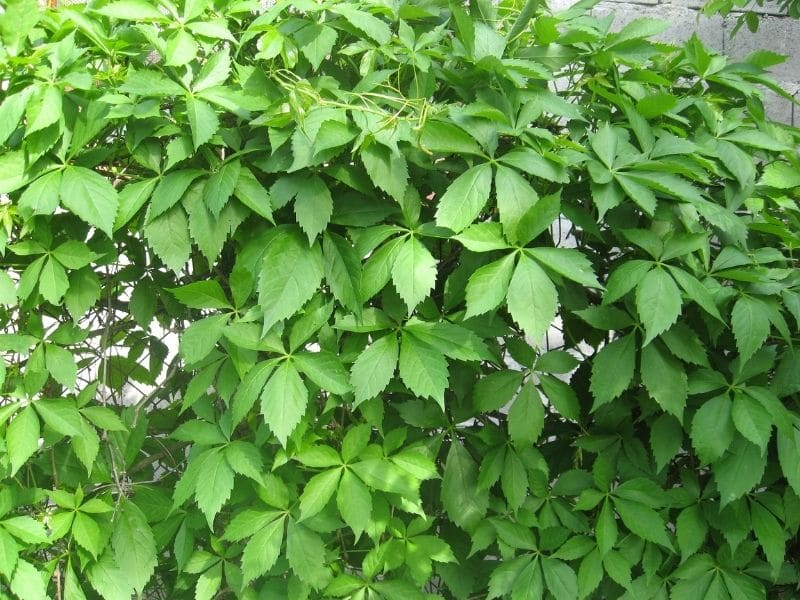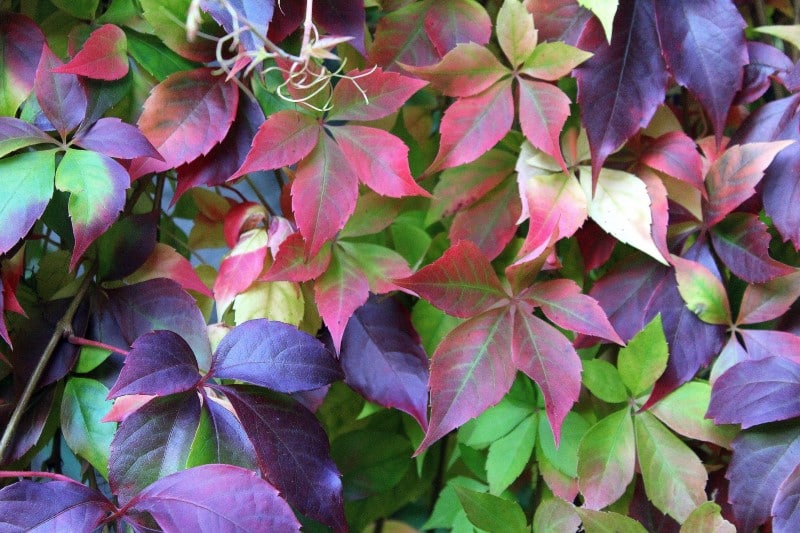The common saying, “Looks can be deceiving”, is proven true by the Virginia Creeper Vine. This broadleaf deciduous climbing plant will surely serve the aesthetics and functionality of a landscape.
However, this vine may cause potential problems and harm not only to the existing vegetation but also to users of the space. Hence, proper planning, implementation, and maintenance must be done. The first step in doing this is by knowing more about the plant.
Botanical Information
Parthenocissus quinquefolia is the scientific name of the Virginia Creeper Vine, which also goes by the names American Ivy, False Grape, Five-leaved Ivy, Virginia Creeper, Victoria creeper, Five-leaves, five finger, Wild Wood Vine, American Woodbine, Woodbine, and True Virginia Creeper. The interpretation of its scientific name will give you an idea of what this plant entails.
Its genus, Parthenocissus, is a synthesis of the Greek words parthenos, which means a virgin, and kissos, which means ivy. This is why it is commonly mistaken as the Poison Ivy. However, the species of the Virginia Creeper, quinquefolia, translates to five-leaves.
Poison Ivy and Virginia Creeper differ by the number of their leaflets, wherein the former has three and the latter commonly has five and sometimes seven.
Belonging to the same family as grapes (Vitaceae), the Virginia Creeper shares certain traits with its fruity relatives. These include its climbing nature, tendrils, leaves, and blue berries. Additionally, it is drought tolerant, adapting well to varying soil conditions and water availability.

Spatial distribution
The Virginia Creeper is native to Mexico, Eastern, and Central North America. It loves to grow on areas wherein the soil is not too wet nor too dry, and has good drainage. Given this preference, the vine is commonly seen on shaded woods, streamsides, open woodlands, riverbanks, chaparral, and brush countries.
It is best planted in USDA Zones 3 to 9.

Leaves
As one of the main attractions of the American Ivy, its leaves are alternate, serrated, and palmate with usually 5 to 7 leaflets. The leaves change their colors as the seasons come and go. It has a purple pigment during early spring. As summer comes, it matures to a flat green pigment. During fall, their leaves are more captivating with colors varying from royal violet to crimson red.
Flowers
The P. quinquefolia gives off subtle and simple flowers that are often white or green. The inconspicuous flowers are often seen at the lead apices during the months of May or June, when they normally bloom.
Fruit and Seeds
As part of the grape family, fleshy fruits arise after the flowers were pollinated. It comes in the colors blue, black, or purplish-black.
Growth and Development
As a deciduous vine, the Virginia Creeper vastly grows wherever it is planted. Oftentimes, its growth is hindered by the lack of supporting structures where it attaches, such as trellises, barks, and rocks. The vine can go as high as 30 to 50 feet, and as wide as 5 to 10 feet.

How to grow Virginia creeper
Sun Requirement
Virginia creeper thrives in full sun to partial shade, ideally receiving at least 6 hours of direct sunlight daily. Adequate sunlight is crucial for its vigorous growth and vibrant foliage.
In full sun, Virginia creeper exhibits its best growth, producing lush green leaves that turn brilliant red in autumn. Insufficient sunlight can result in sparse foliage and weak growth, diminishing its ornamental appeal. While it can tolerate some shade, too much shade may lead to leggy growth and reduced flowering.
Therefore, you should plant Virginia creeper in a sunny location to ensure optimal health and visual impact in landscapes.
Water Requirements
Five-leaved ivy can grow in areas with low moisture. However, watering, as part of the maintenance plan, should be scheduled every so often to keep the soil moist enough.
Temperature and Humidity Requirements
This hardy plant withstands most climatic conditions and is not that sensitive to temperature.
Fertilizer
Application of fertilizer should be done as needed, depending on the soil fertility status. During its flowering stage, it is better to avoid the application of nitrogen fertilizers as it will encourage leaf formation and may hinder flower formation.
Soil Requirements
Given its native habitats, the Virginia Creeper prefers to grow in well-drained soils with adequate soil moisture. This means the soil should hold enough water for the plant’s needs but also drain well enough to prevent root rot.
Rocky, clay, limestone-rich caliche, clay loam, loam, sandy loam, and sandy soils are the soil types that are most beneficial for the plant’s growth. It also thrives in soils that vary in pH levels, whether it be acidic, neutral, or alkaline.
Pests and diseases
Common pest and plant diseases affecting Virginia creeper include aphids, scale insects, and powdery mildew. Aphids and scale insects feed on the plant sap, causing leaf distortion and yellowing.
Regular inspection and treatment with insecticidal soap or neem oil can help control infestations. Powdery mildew, a fungal disease, manifests as a white powdery coating on leaves, often in humid conditions. According to mature dimensions and avoiding overhead watering, space plants can mitigate its spread.
Vigilance in monitoring for these pests and diseases, coupled with appropriate management strategies, helps maintain the health and vitality of this fast growing vine in gardens and landscapes.
Propagation
Commonly, the American Ivy is reproduced through seeds. After the flowers have been pollinated by insects and birds in early summer, berries are formed. These berries ripen and turn bluish-black, becoming succulent indicators of readiness.
Extract the seeds from the ripened berries and air dry them thoroughly. Store the seeds in an airtight container under low temperatures for later use.
In choosing the right woody stem to cut, choose a half-ripe stem, around 2.5 to 4 inches long with the presence of 2 true buds, at least. Application of root hormone in the right amounts may be beneficial for root development. In terms of layering, usually, this climbing vine can undergo self-layering.
Trimming
Removal of dead plant parts should be scheduled every 2 or 3 weeks to ensure the plant’s vitality. Also, it helps lower the vine’s susceptibility to various insect pests and diseases.
Deadheading or removal of dried flowers should be done if fruiting is not a priority. Trimming of old leaves will rejuvenate and promote the production of new leaves. It is also recommended to trim regularly to keep the plant’s shape for the landscape.

Potential Harm
Aside from the possibility of establishing strong competition towards other plants in the landscape, the Virginia creeper plants also impose harm to the users.
The berries are highly toxic when ingested. Nausea, vomiting of blood, diarrhea, abdominal pain, excessive sweating, weak pulse, headache, drowsiness, and twitching of the face are some of the symptoms of being poisoned by the Virginia creeper vines.
The vine’s tissues also contain raphides, which cause skin irritation. Compared to the Poison Ivy or Toxicodendron radicans, the effects are less severe but the resemblance makes people assume that the Virginia creeper is poison ivy.
Uses
More often than not, vines, such as the Virginia Creeper, are used to soften existing man-made fixtures. It is left to climb and twine trellises, arbors, fences, and green walls. Having broad leaves makes it suitable as a screen or privacy fence. Additionally, it can be used for erosion control as a ground cover vine too.
For the wildlife, the P. quinquefolia serves as a food source and habitat for fruit birds, nuthatches, mockingbirds, catbirds, swallows, woodpeckers, and chickadees during winter. It also serves as a larval host for various sphinx moth species.

Common Cultivars and Varieties of Virginia Creeper Plant
Engelmann’s ivy
The cultivar Parthenocissus quinquefolia var. engelmannii goes by the name Engelmann’s Ivy. Compared to the other cultivars, it grows slower, climbs faster, and has smaller leaves. The size of its foliage makes it more suitable for small gardens.
Variegata
The Variegata variety, just like the Engelmann’s Ivy, is less aggressive, which makes it good for small yard gardens. Its leaves are characterized by white and yellow variegations which change to red and pink during Fall.
Red Wall
The Red Wall variety is also known as Troki, and it gives rise to a bright red color during early fall. It can be used to add color to your walls or fences but is not recommended to be planted near buildings.
Monham
Monham or Star Showers have white variegations in their foliage which turns to light pink during the fall. The leaf variegations resemble a splat of paint.
Yellow Wall
The Yellow Wall is a variety of Virginia Creeper Vine that gives an eye-catching yellow gold color during fall. In garden exhibits and shows, the yellow wall and red wall are often showcased together in a design. This variety is optimized by letting it crawl and cover fences or living walls.
FAQs
Should Virginia creeper be cut back?
Virginia creeper can benefit from occasional pruning to control its growth and shape, especially if it becomes too dense or invasive. Prune in late winter or early spring before new growth begins.
Does Virginia creeper stay green all year?
Virginia creeper is deciduous, meaning it loses its leaves in the winter and remains bare until new growth emerges in spring. While it stays green throughout the growing season, it does not retain its foliage year-round.
Does Virginia creeper need a trellis?
No, the Virginia creeper generally does not require a trellis for support because it is a vigorous climber and can attach itself to surfaces using aerial roots. However, providing a trellis or other support structure can help train the vine and guide its growth in the desired direction.
Is it OK to touch Virginia creeper?
While Virginia creeper is not toxic to touch, some individuals may experience skin irritation or allergic reactions upon contact with its sap or foliage. It’s advisable to wear gloves and long sleeves when handling the plant, especially if you have sensitive skin or known allergies.
What are alternatives to Virginia Creeper?
Consider planting Boston Ivy or Climbing Hydrangea as alternatives to Virginia Creeper. These vines offer similar climbing habits and attractive foliage, with Boston Ivy displaying stunning autumn colors and Climbing Hydrangea producing fragrant summer blooms. Both plants are excellent choices for covering walls, fences, or trellises in your garden.
Final thoughts
In conclusion, proper Virginia creeper plant care is essential for maintaining the health and beauty of your ground cover plants in gardens and landscapes. By following the guidelines outlined in this article, including providing adequate sunlight, ensuring well-drained soil, and regular watering, enthusiasts can cultivate thriving specimens.
With attention to these key aspects of care, Virginia creeper can flourish, adorning outdoor spaces with its stunning foliage and vibrant colors throughout the seasons. Embracing these practices ensures a successful and rewarding experience for any gardener.
For more cool vines to grow, check our list of vines.
*image by Loraliu/depositphotos







